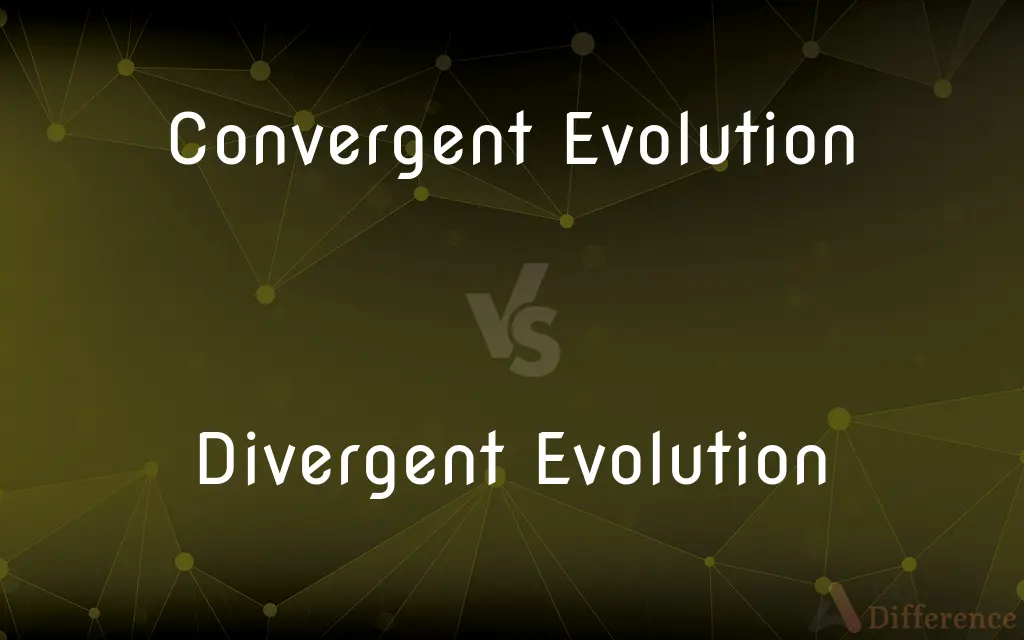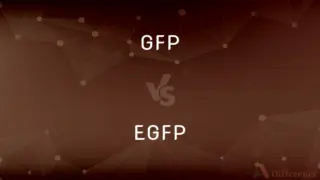Convergent Evolution vs. Divergent Evolution — What's the Difference?
By Tayyaba Rehman — Published on December 12, 2023
Convergent Evolution involves unrelated species developing similar traits due to similar environments. Divergent Evolution is when related species evolve different traits due to varied environments.

Difference Between Convergent Evolution and Divergent Evolution
Table of Contents
ADVERTISEMENT
Key Differences
Convergent Evolution describes a phenomenon where unrelated species evolve to have similar traits, often as a result of adapting to similar environments or ecological niches. Divergent Evolution, on the other hand, refers to a process where closely related species evolve to have distinct traits because they adapt to different environments.
The driving force behind Convergent Evolution is usually similar environmental pressures that lead distinct species to develop similar adaptive solutions. In contrast, Divergent Evolution is driven by differing environmental pressures on related species, causing them to evolve differently over time.
An example of Convergent Evolution can be seen in the similar streamlined body shapes of dolphins (mammals) and sharks (fish), both adapted for fast swimming. A case of Divergent Evolution can be observed in the Galapagos finches, where related species developed different beak shapes to exploit various food sources.
While Convergent Evolution illustrates how nature can arrive at similar solutions for different organisms facing analogous challenges, Divergent Evolution emphasizes the uniqueness and specificity of adaptation based on distinct environmental influences on related species.
In essence, Convergent Evolution highlights similarities across unrelated lineages, revealing nature's recurring themes. Divergent Evolution, conversely, underscores the evolutionary paths that lead to greater diversity within related lineages, demonstrating nature's adaptability.
ADVERTISEMENT
Comparison Chart
Definition
Unrelated species evolve similar traits.
Related species evolve different traits.
Driving Force
Similar environmental pressures.
Different environmental pressures.
Relationship Between Species
Unrelated species.
Closely related species.
Result
Similar traits in different lineages.
Diverse traits within a lineage.
Example
Dolphins and sharks' body shapes.
Galapagos finches' beak shapes.
Compare with Definitions
Convergent Evolution
Nature's way of finding similar solutions for different organisms.
Convergent Evolution has led to flying squirrels in North America and flying phalangers in Australia.
Divergent Evolution
Evolutionary pattern resulting in species specialization within a common lineage.
Divergent Evolution is responsible for the different types of big cats like lions, tigers, and leopards.
Convergent Evolution
Evolutionary pattern resulting in shared traits among unrelated groups.
The similar body forms of ichthyosaurs (extinct reptiles) and dolphins show Convergent Evolution.
Divergent Evolution
Adaptation in related species due to different environmental challenges.
The different types of bear species around the world are a result of Divergent Evolution.
Convergent Evolution
Evolutionary process where different species develop similar traits.
The wings of bats and insects are a result of Convergent Evolution.
Divergent Evolution
Evolutionary process where related species develop distinct traits.
Divergent Evolution is evident in the varied beak shapes among Galapagos finches.
Convergent Evolution
Adaptation in unrelated species due to similar environmental challenges.
Cacti in America and Euphorbias in Africa show Convergent Evolution in desert environments.
Divergent Evolution
Nature's way of diversifying traits among related groups.
The marsupial mammals in Australia exhibit Divergent Evolution from their placental counterparts.
Convergent Evolution
Independent evolution leading to analogous structures in distinct species.
The camera-like eyes of octopuses and humans are an example of Convergent Evolution.
Divergent Evolution
Branching evolutionary pattern leading to species diversity within a lineage.
Divergent Evolution led to the various breeds of domesticated dogs from a common ancestor.
Common Curiosities
What's the primary difference between Convergent Evolution and Divergent Evolution?
Convergent Evolution involves unrelated species developing similar traits, while Divergent Evolution involves related species developing distinct traits.
Is Divergent Evolution a result of species moving to different environments?
Yes, different environments often drive related species to evolve distinct traits.
Why does Convergent Evolution occur?
It's usually due to unrelated species facing similar environmental challenges.
Can you give an example of Convergent Evolution?
The wings of birds and bats showcase Convergent Evolution.
What's a well-known case of Divergent Evolution?
The beak variations among Galapagos finches exemplify Divergent Evolution.
Is Divergent Evolution responsible for the diversity of life?
It's one of the processes that contribute to the vast diversity we see in related groups.
Does Convergent Evolution mean species share a recent common ancestor?
No, it involves unrelated species developing analogous traits.
Can Divergent Evolution lead to species that no longer resemble each other?
Absolutely, related species can evolve to look or behave very differently over time.
Can Convergent Evolution lead to species looking nearly identical?
Yes, unrelated species can appear very similar due to similar adaptive needs.
Are the similar traits from Convergent Evolution inherited from a shared ancestor?
No, they develop independently in response to similar environmental challenges.
Why are the results of Convergent Evolution sometimes so surprising?
Because unrelated species can end up looking or behaving very similarly due to similar ecological pressures.
How does Divergent Evolution affect a single species lineage?
It can lead to multiple distinct species originating from a single ancestral species.
Can Divergent Evolution result from behavioral differences in related species?
Yes, behavioral differences can drive related species to adapt and evolve distinct traits.
Does Convergent Evolution suggest that there are optimal solutions in nature?
It suggests that there are recurring solutions to certain environmental challenges.
Is Divergent Evolution a primary driver of speciation?
Yes, it's one of the key processes that lead to the formation of new species.
Share Your Discovery

Previous Comparison
Christians vs. Catholics
Next Comparison
GFP vs. EGFPAuthor Spotlight
Written by
Tayyaba RehmanTayyaba Rehman is a distinguished writer, currently serving as a primary contributor to askdifference.com. As a researcher in semantics and etymology, Tayyaba's passion for the complexity of languages and their distinctions has found a perfect home on the platform. Tayyaba delves into the intricacies of language, distinguishing between commonly confused words and phrases, thereby providing clarity for readers worldwide.












































